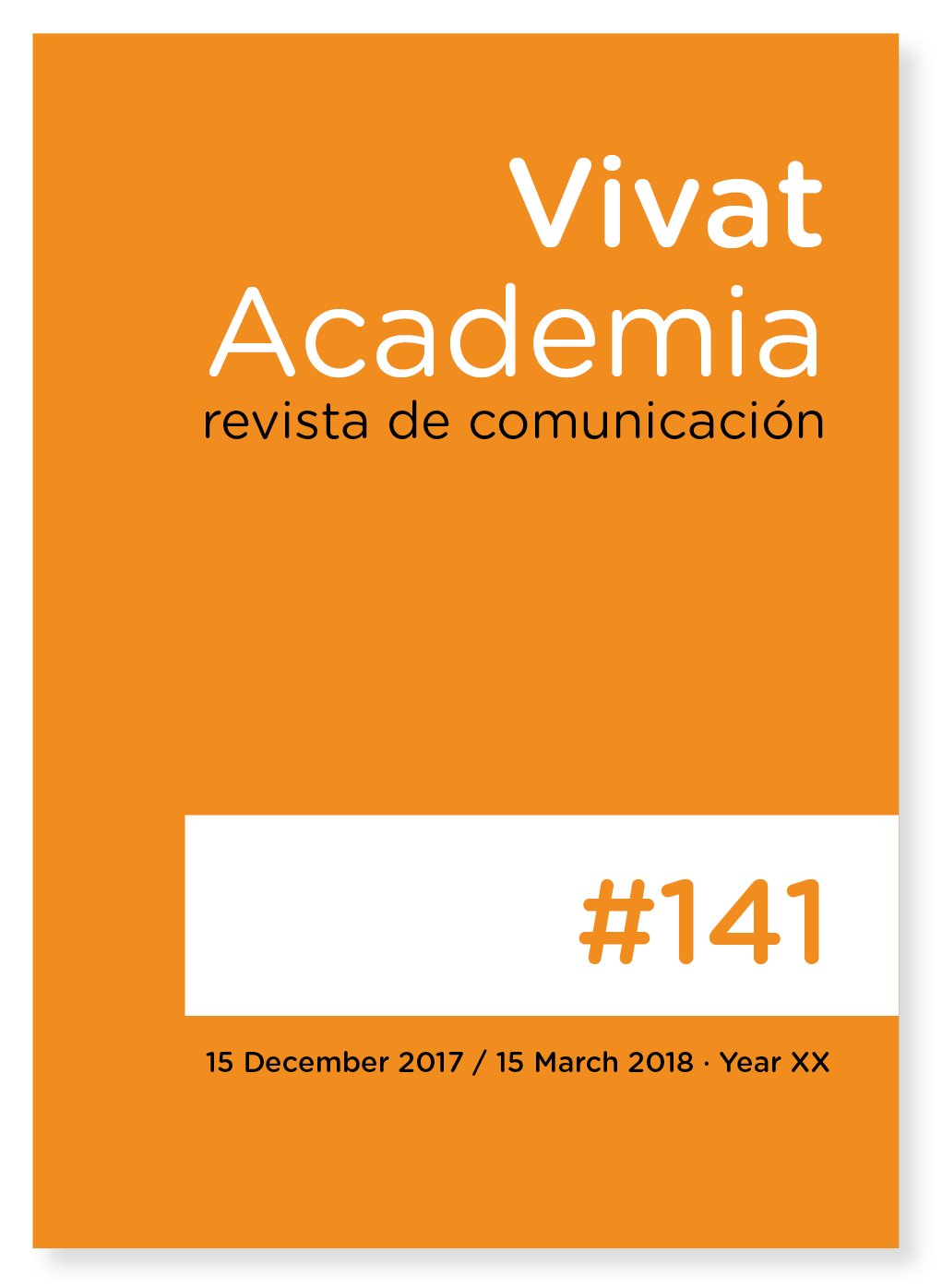Gender differences in audiovisual consumption: a neuroscience experiment on tv ads
Main Article Content
Abstract
This paper shows the results of an experiment in neuroscience on a group of 20 people applied to audiovisual consumption, particularly television spots. The method used was the measurement and analysis of their electrodermal activity. The results indicate significant differences in attention by gender. The most notable increases seem to be more related to the sound than to the picture. The comic theme aroused a higher level in men but not in women. Similarly, the novelty seems to be an important factor in generating attention and excitement, as the spots not issued inSpainhad significantly higher values on attention and emotion. Finally, the spots where the language of speech was not Spanish also had significantly higher values in attention, but not in emotion.
Downloads
Article Details
The main author must deliver the letter of transfer of copyright, according to the model provided by Vivat Academia, Revista de comunicación, which declares the transfer of copyright to the journal and make explicit the rights of authors regarding the dissemination and use of the manuscript once published.
Creative Commons Attribution/Non Commercial 4.0 International
References
Aiger, M.; Palacín, M. & Cornejo, J.M. (2013). La señal electrodérmica mediante Sociograph: metodología para medir la actividad grupal. Revista Internacional de Psicología Social: International Journal of Social Psichology, 28 (3), 333-347.
Avendaño Castro, W. (2013). Un caso práctico para el análisis del neuromarketing visual en el centro comercial Ventura Plaza (Cúcuta, Colombia). Cuadernos de la administración, 29 (49), 17-27.
Beer, J. & Lombardo, M. (2007). Insights into Emotion Regulation from Neuropsychology. En J. Gross, J. Handbook of Emotion Regulation (pp. 69-86). New York: Guilford Press.
Blakeslee, S. (2004) If You Have a 'Buy Button' in Your Brain, What Pushes It? New York Times, 19 de Octubre.
Burgos-Campero, A. & Vargas-Hernández, J. (2013). Analitical approach to neuromarketing as a business strategy Procedia - Social and Behavioral Sciences 99, 517– 525. http://dx.doi.org/10.1016/j.sbspro.2013.10.521
Dapkevicius, A. & Melnikas, B. (2009). Influence of Price and quality to customer satisfaction: neuromarketing approach. Vilniaus Gedimino technikos universitetas, 3, 17-20. http://dx.doi.org/10.3846/144.
El Comercio (2013). ¿Te asusta? Este es el comercial de TV que aterroriza a Japón Recuperado de: http://elcomercio.pe/mundo/actualidad/este-comercial-llantas-que-aterroriza-japon-ti-video-noticia-1668371.
El Hombre Anuncio (2013). Autoway y el anuncio más terrorífico del mundo
Recuperado de: http://www.elhombreanuncio.com/autoway-y-el-anuncio-mas-terrorifico-del-mundo/
Fugate, D. (2007). Neuromarketing: a layman's look at neuroscience and its potential application to marketing practice. Journal of Consumer Marketing, 24 (7), 385–394. http://dx.doi.org/10.1108/07363760710834807.
Gil-Lafuente, J.; Vidal, J.M. & Aymerich Martínez, J. (2010). The optimization of investment in POS advertising through a fuzzy model based on the application of neuromarketing techniques. Computational Inteligence in Business and Economics, 3, 431-441. http://dx.doi.org/10.1142/9789814324441_0052
Infotaller.tv (2013) Un spot de neumáticos de invierno aterroriza internet. Recuperado de: http://www.infotaller.tv/neumaticos/actualidad/un-spot-de-neumaticos-de-invierno-aterroriza-internet.
Karmarkar, U., Yoon, C. & Plassmann, H. (2015). Marketers should pay attention to fMRI. Harvard Business Review. Recuperado de HTTP:goo.gl/5tDXbJ.
Martínez Herrador, J.L.; Garrido Martín, E.; Valdunquillo Carlón, M.I. & Macava Sánchez, J. (2008). Análisis de la atención y la emoción en el discurso político a partir de un nuevo sistema de registro psicofisiológico y su aplicación a las ciencias políticas. DPSA. Documentos de trabajo del Departamento de Psicología Social y Antropología, 2.
Martínez Herrador, J.L; Monge Benito, S. & Valdunquillo Carlón, M.I. (2012). Medición de las respuestas psicofisiológicas grupales para apoyar el análisis de discursos políticos. Trípodos, 29, 53-72.
Medrano Samaniego, C. (2010). Los programas y características de los personajes preferidos en el visionado de la televisión: diferencias evolutivas y de sexo. Cultura y Educación, 22(1), 3-20. http://dx.doi.org/10.1174/113564010790935196
Morin, C. (2011) Neuromarketing: The New Science of Consumer Behavior. Symposium: Consumer culture in global perspective, 131-135. http://dx.doi.org/10.1007/s12115-010-9408-1
Muñoz Sánchez, O. (2012). La emoción y la razón en la estructura del pensamiento estratégico publicitario. Una visión de la marca desde la psicología cognitiva y la neurociencia. Tripodos, 29, 39-52.
Nikula, R. (2007) Psychological Correlates of Nonspecific Skin Conductance Response. Psichophysiology. 28(1), 86-90. http://dx.doi.org/10.1111/j.1469-8986.1991.tb03392.x
Orzan, G.; Zara, I. & Purcarea, V.L. (2015). Neuromarketing techniques in pharmaceutical drugs advertising. A discussion and agenda for future research. Journal of medicine and life, 5 (4) 428-432.
Reason Why (2013) El spot de terror japonés que arrasa en todo el mundo
Recuperado de http://www.reasonwhy.es/actualidad/campanas/el-spot-de-terror japones-que-arrasa-en-todo-el-mundo_2013-12-04.
Reimann, M.; Castano, R.; Zaichkowsky, J. & Bechara, A. (2012). Novel versus familiar brands: an analysis of neurophysiology, response latency and choice. Marketing letters, 23 (3), 745-759. doi:http://dx.doi.org/10.1007/s11002-012-9176-3
RRPP Noticias (2013) Japoneses aterrorizados con spot no apto para cardiacos.
Recuperado de http://www.rpp.com.pe/2013-12-04-japoneses-aterrorizados-con-spot-no-apto-para-cardiacos-noticia_652522.html.
Touhami, Z.O; Benlafkin, L.; Jiddane, M.; Cherrah, Y.; El Malki, H. & Benomar, A. (2011) Neuromarketing: Where marketing and neuroscience meet African Journal of Business Management, 5(5), 1528-1532. http://dx.doi.org/10.5897/AJBM10.729
Vecchiato, G.; Cherubino, P.; Maglione, A.G.; Ezquierro, M.T.H.; Marinozzi, F.; Bini, F.; Trettel, A. & Babiloni, F. (2014). Neurophysiological tools to investigate consumer´s gender differences during the observation of TV commercials. Computational and mathematical methods in medicine, 91, 29-81. doi:http://dx.doi.org/10.1155/2014/912981





